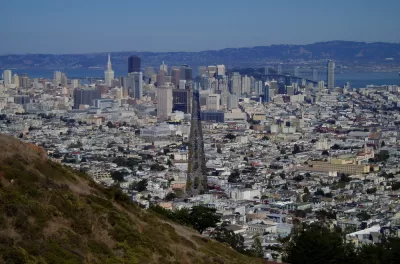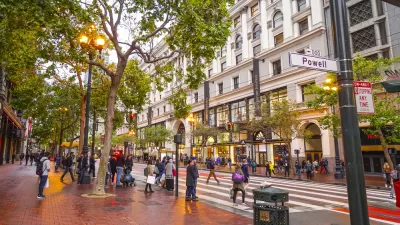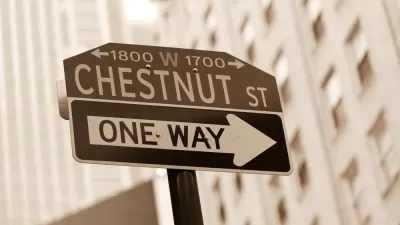Private automobiles could be prohibited on San Francisco's primary downtown thoroughfare, and already-wide sidewalks could be extended and smoothed over. The Better Market Street project is ready for its close up.

John King reports on proposed changes Market Street in San Francisco, headlined by the complete banning of cars from a particularly busy stretch the street known as Mid-Market.
After several previous efforts to improve the street by preventing cars from turning onto the street, reclaiming public space, and improve access for people with disabilities, King describes the plan expected before the San Francisco Planning Commission this week to give the street what it finally, really needs: a fresh start.
Here are some of details described by King about the project under consideration by the Planning Commission this week:
The first phase of the upgrade would extend from Fifth Street to Eighth Street, a $150 million investment in what the city calls Better Market Street. Eventually, the improvements will stretch 2.2 miles between the Embarcadero and Octavia Boulevard, at a current estimated cost of $604 million, some of which will be for sewer and utility updates that were needed anyway.
Market Street will be off-limits to private vehicles east of 10th Street, and commercial loading will only be permitted during specific hours. Ride-hailing companies will only be permitted to drop-off and pick-up in designated zones on side streets.
The already-wide sidewalks would be broadened from 35 to 37 feet, with as much as 12 feet along the curb reserved for bicycle lanes and a curbside buffer zone. The red bricks with their herringbone pattern would be replaced by gray concrete pavers that are easier to clean and repair and more hospitable to wheelchair users.
As noted by King, the process of approving the $604 million project has taken a long time—Planetizen first picked up news of the project in 2017. The final product might just be worth it, however. "Details can be quibbled with, and the process has taken twice as long as it should have, but the results have a disciplined clarity that public initiatives so often lack," writes King.
If planning and construction proceeds from this point as hoped, construction could begin in 2021.
FULL STORY: Market Street makeover — safe bike lanes and no cars — finally at hand

Alabama: Trump Terminates Settlements for Black Communities Harmed By Raw Sewage
Trump deemed the landmark civil rights agreement “illegal DEI and environmental justice policy.”

Planetizen Federal Action Tracker
A weekly monitor of how Trump’s orders and actions are impacting planners and planning in America.

Why Should We Subsidize Public Transportation?
Many public transit agencies face financial stress due to rising costs, declining fare revenue, and declining subsidies. Transit advocates must provide a strong business case for increasing public transit funding.

Understanding Road Diets
An explainer from Momentum highlights the advantages of reducing vehicle lanes in favor of more bike, transit, and pedestrian infrastructure.

New California Law Regulates Warehouse Pollution
A new law tightens building and emissions regulations for large distribution warehouses to mitigate air pollution and traffic in surrounding communities.

Phoenix Announces Opening Date for Light Rail Extension
The South Central extension will connect South Phoenix to downtown and other major hubs starting on June 7.
Urban Design for Planners 1: Software Tools
This six-course series explores essential urban design concepts using open source software and equips planners with the tools they need to participate fully in the urban design process.
Planning for Universal Design
Learn the tools for implementing Universal Design in planning regulations.
Caltrans
Smith Gee Studio
Institute for Housing and Urban Development Studies (IHS)
City of Grandview
Harvard GSD Executive Education
Toledo-Lucas County Plan Commissions
Salt Lake City
NYU Wagner Graduate School of Public Service





























